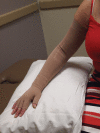Lymphedema: Conventional to Cutting Edge Treatment
- PMID: 32773955
- PMCID: PMC7394577
- DOI: 10.1055/s-0040-1713447
Lymphedema: Conventional to Cutting Edge Treatment
Abstract
Lymphedema of the extremities related to oncologic therapies such as cancer surgery, radiation therapy, and chemotherapy is a major long-term cause of morbidity for cancer patients. Both nonsurgical and surgical management strategies have been developed. The goals of these therapies are to achieve volume reduction of the affected extremity, a reduction in patient symptoms, and a reduction in associated morbidities such as recurrent soft-tissue infections. In this article, we review both nonsurgical and surgical management strategies. Traditional surgical therapy has focused on more ablative techniques such as the Charles procedure and suction-assisted lipectomy/liposuction. However, newer more physiologic surgical methods such as lymphovenous anastomoses and vascularized lymph node transfers have become a more common treatment modality for the management of this complex problem.
Keywords: interventional radiology; lymphedema; lymphovenous bypass; vascularized lymph node transfer.
© Thieme Medical Publishers.
Conflict of interest statement
Conflict of Interest The authors have nothing to disclose.
Figures












References
-
- Warren A G, Brorson H, Borud L J, Slavin S A. Lymphedema: a comprehensive review. Ann Plast Surg. 2007;59(04):464–472. - PubMed
-
- Rockson S G, Rivera K K. Estimating the population burden of lymphedema. Ann N Y Acad Sci. 2008;1131:147–154. - PubMed
-
- Allen R J, Jr, Cheng M H. Lymphedema surgery: patient selection and an overview of surgical techniques. J Surg Oncol. 2016;113(08):923–931. - PubMed

